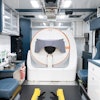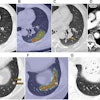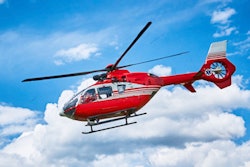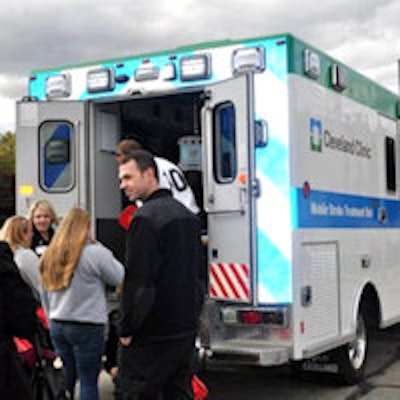
A mobile stroke treatment unit with a CT scanner and medical personnel aboard is dramatically cutting time-to-treatment decisions for Cleveland stroke patients. Clot-busting drugs were provided in nearly half the usual time, according to a study presented at this week's 2015 International Stroke Conference in Nashville, TN.
Every minute counts in the treatment of acute ischemic stroke, and researchers from the Cleveland Clinic Foundation say they have substantially reduced several factors that can delay treatment.
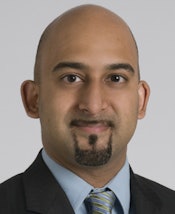 Dr. Muhammad Shazam Hussain from the Cleveland Clinic.
Dr. Muhammad Shazam Hussain from the Cleveland Clinic.For patients who received care from the special stroke unit, CT scans were completed in a median time of 13 minutes after arrival of the unit, the group found. Among patients who received clot-busting medication for ischemic stroke, time to treatment with tissue plasminogen activator (tPA) was an hour for those headed to the hospital via a traditional ambulance, compared with 30 minutes for patients following the arrival of the mobile unit.
Time from initial alarm to treatment was also reduced substantially, said Dr. Muhammad Shazam Hussain, senior author and head of stroke imaging at the Cleveland Clinic Foundation, in an interview with AuntMinnie.com. The results parallel those of a similar study in Germany that used a CT-equipped mobile stroke ambulance.
"In our first 100 patients, we've basically replicated the results seen in Germany -- about 40 minutes time to treatment" from the time the call is first received, Hussain said. "When you're talking about losing 2 million brain cells a minute, that's a lot of brain adding up."
Ongoing study
The ongoing, prospective study in Cleveland has compared several time parameters for acute stroke patients treated in a mobile stroke unit versus those brought to the hospital in a traditional ambulance. The data span July 18, 2014, to the end of November, when the group reached its 100th transported patient.
The primary end point is a comparison of the alarm-to-therapy decision; secondary end points include time from the alarm to CT completion, time from the alarm to lab analysis, the number of patients receiving IV tPA, and seven-day neurological outcomes as assessed by the U.S. National Institutes of Health Stroke Scale (to be analyzed in a future study).
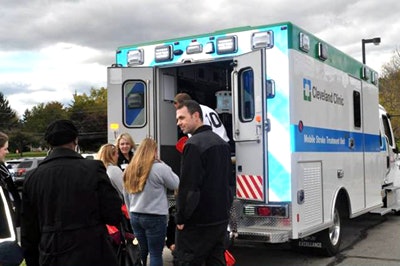 EMTs and stroke unit personnel move a patient into the mobile stroke unit. Image courtesy of Dr. Muhammad Shazam Hussain.
EMTs and stroke unit personnel move a patient into the mobile stroke unit. Image courtesy of Dr. Muhammad Shazam Hussain.The stroke unit is equipped with a CereTom mobile CT scanner (NeuroLogica) to rule out bleeding. Onboard staff includes a CT technologist, registered nurse, paramedic, and emergency medicine personnel. Unlike other mobile units that have a neurologist or neuroradiologist on board for all calls, in this pilot project, the neurological expertise is handled entirely through a teleradiology connection to the hospital, Hussain said.
"All the other places that use this have a physician on board, but we think it's really important to use the telemedicine capabilities to make it cost-effective, because that's what you're going to need to do," he said.
Evaluation and treatment of the first 100 mobile unit patients were compared with conventional care -- i.e., a control group of 53 stroke patients brought to one of two centers' emergency departments via ambulance during the three months before the stroke unit went into operation. There were no significant demographic or geographic differences between the two patient groups.
When the unit is operating during daytime hours, seven days a week, Cleveland emergency medical services personnel are dispatched concurrently with the stroke unit. They arrive first on the scene and draw blood samples.
With the mobile unit, median alarm-to-CT-completion time was significantly reduced (33 minutes in the stroke unit versus 56 minutes for the controls), as was median alarm-to-thrombolysis time (55.5 minutes in stroke unit versus 94 minutes for controls), Hussain reported. As of late November, 16 patients had received IV tPA in the unit, compared with 12 in the hospital, and no adverse events from treatment had been reported.
| Mobile stroke unit vs. ambulance delivery to hospital | |||
| Mobile stroke unit | Controls | p-value | |
| Alarm to CT completed | 33 minutes | 56 minutes | < 0.0001 |
| Alarm to CT read | 44 minutes | 64 minutes | < 0.0001 |
| No. of patients receiving tPA | 16 (16%) | 12 (22.6%) | 0.31 |
| Alarm to IV tPA | 55.5 minutes | 94 minutes | < 0.0001 |
| Door to IV tPA | 31.5 minutes | 58 minutes | 0.0012 |
"If you take it a step further and talk about when the 911 call was, or when did the dispatch take place, and then measure time to treatment, that's when you're really seeing substantial time savings because you don't have to worry about transporting the patient to the hospital and wasting all that time," Hussain said.
Based on all the parameters measured, use of the mobile stroke treatment unit resulted in faster times to evaluate and treat patients compared with traditional models, regardless of where the patient was ultimately sent, the researchers concluded.
"We want to serve all of the people of Cleveland, so we've been trying to be very fair about sending patients to all of the different hospitals," Hussain said. "We're just making sure they have the right capabilities to take care of patients, so if they have more severe strokes, we try to send them to the larger centers. But there's a lot of work that goes into developing those algorithms, and we're still working on all that."
Regarding a full assessment of the stroke unit's value, the work is just beginning, he said. An analysis of patient outcomes in the hospital versus the stroke unit tops the list.
"It's a little bit early, and we haven't been able to collect all the outcomes data yet," Hussain said, so the next thing to address is the outcomes and then cost-effectiveness. But for now, "I think we replicated the time savings we saw in Germany."



